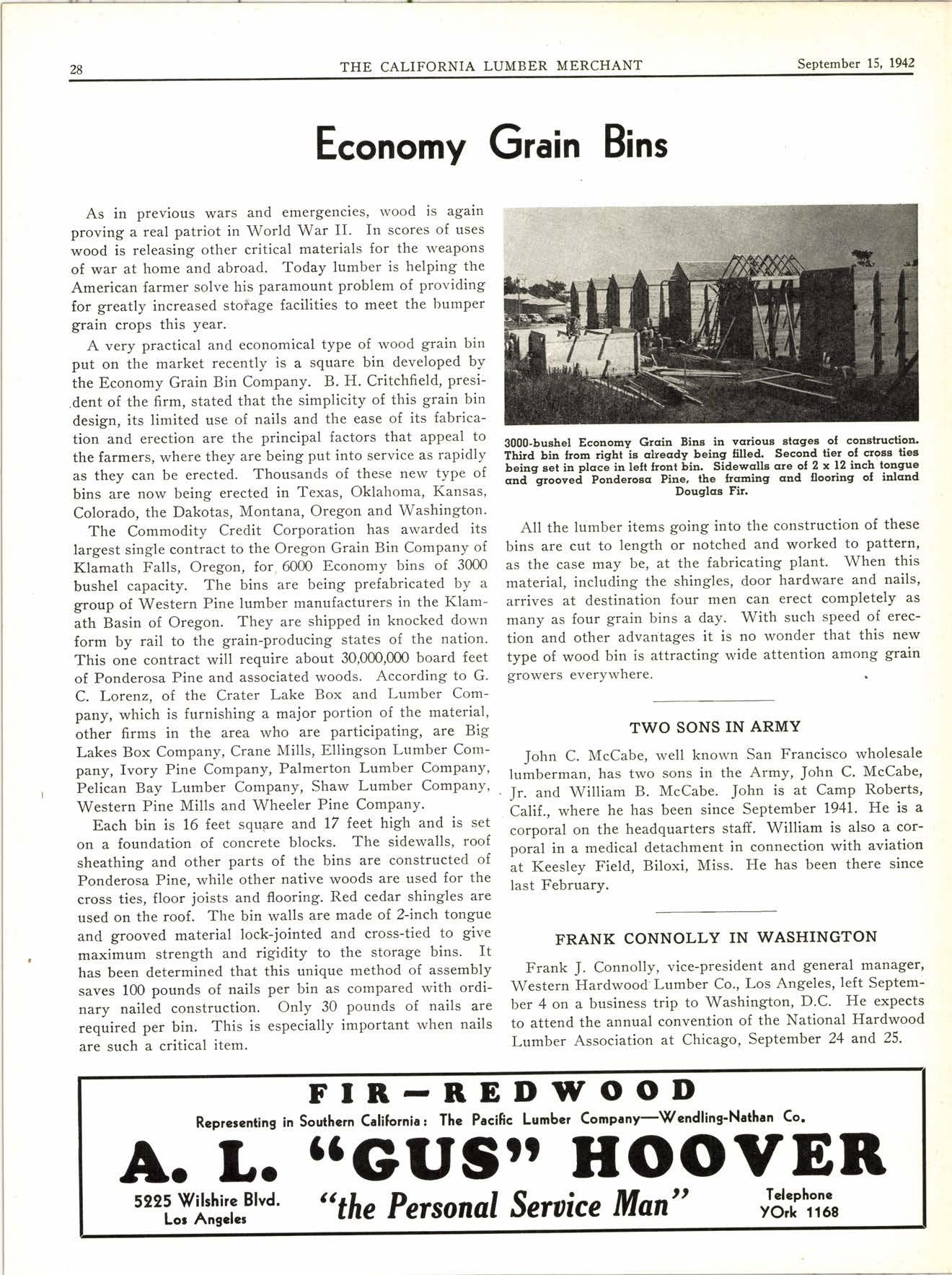
3 minute read
Maximum Prices of Softwood Lumber From Dftribution Yards Set bv OPA
San Francisco, Sept. 4Establishment of maximum prices for sales of softwood lumber from distribution yards, including such important industrial lumbers as Southern pine, Western pine, Douglas fir and hemlock, was announced today by Price Administrator Leon Henderson, the regional OPA reported.
The new regulation-titled maximum price regulation No. 215, distribution yard sales of softwood-is the first lumber schedule which deals with shipments of lumber from distribution yards, all previous specific regulations having applied only to sales where shipment originates at mills.
The species of softwood covered by the measure include all woods for which maximum mill prices have been established in previous specific regulations, or over 90 per cent of all softwood normally handled by distribution yards. The regulation, which removes these softwoods 'sold by yards from the provisions of the General Maximum Price Regulation, is effective September lO, 1942.
"IJse of the March, 1942, base for yard sales of softwood lumber has caused complaints of inequities in some instances and, in others, has provided sellers with unwarranted profit margins," the administrator explained. "The need for general relief in some areas, and downward revision in prices in other areas, has become apparent."
Specific dollars and cents prices are established by the regulation, the individual seller determining his maximum price according to the sum of several charges and additions. The ceiling price is the sum of : tice of determining selling prices. Its effect on the prices yards have been charging under the general regulation will vary, depending upon how closely the individual distributor's prices are adjusted to the mill ceiling price for lumber.
Application of the formula will give relief to distributors whose March selling prices do not reflect certain increases in costs. A yard, for example, whose prices under the general regulation were based on water transportation rated for incoming material, rather than the more expensive rail transportation now being used, will realize a more normal margin under the formula.
The F.O.B. mill maximum price of the formula is based on the regulation which governs the lumber being purchased -maximum price regulation No. 19, Southern pine; maximum price regulation No. 26, Douglas fir and other West Coast lumber; revised price schedule No. 94, Western pine lumber; and maximum price regulation No. 104, red cedar shingles.
Price Changes inl(/estern Wooden Agricultural Containers
Washington, September 2.-Certain minor changes in price schedules contained in maximum price regulation No. 186 (Western wooden agricultural containers) are made in amendment No. I to the regulation issued today by the Office of Price Administration. price. The amendment also contains clarifying interpretations l. The F.O.B. mill maximum price for the lumber as determined by the specific regulation governing the mill
2. Inbound freight to the distribution yard as calculated which specify that all "northwest items" not contained in on the basis of a table contained in appendix A of the regu- table 2 of the schedule are to be priced according to table lation. l. In addition, the amendment sets forth the proper
3. Handling charges of-(A) $5.00 per thousand feet for method for calculating footage where prices are stated to lumber, (B) .30 per square for shingles, and (C) . .60 be per thousand feet. This provides that footage shall be per hundred pieces for lath. determined according to the method set forth in "tariff No.
4. A mark-up of 10 per cent of the total of these items. 1, official box and crate specifications of the Pacific division
This pricing method follows the traditional industry prac- of the National Wooden Box Association," as revised.
Loggerr Given Overtimc Plan
Washington, Sept. 3.-In an effort to combat the shortage of labor in West Coast logging, Price Administrator Leon Henderson tonight ordered revisions in price regula: tions, including the establishment of an "overtime addition" system.
Mr. Henderson said the "overtime" system would permit overtime operations and stimulate maximum utilization of available manpower,
The "overtime addition" system permits graduated increases in the prices for logs, in accordance with the extent of the individual company's overtime operations. fn addition, Mr. Henderson ordered an upward adjustment in the ceiling price of hemlock, white fir and noble fir logs.
The order also included the establishment of maximum prices for the new aircraft grade of hemlock and noble fir logs. The order becomes effective September 9.
"The seriousness of this shortage," said Mr. Henderson, "is seen in the fact that the War Production Board estimates lumber production during the current year will fall short of probable demand by six billion feet."
Mr. Henderson said studies in the northwest area had demonstrated that the most important impediment to an increase in lumber production, or even the maintenance of normal production, was the shortage of labor.
"The present amendment establishing a system of overtime additions for overtime operations is designed to make it possible for logging companies to pay overtime labor at the rate of time and a half, and also by encouraging them to extend their operations to the very maximum which is physically possible," Mr. Henderson commented.

The order provides the following specific additions to ceiling prices for overtime production:
For forty-nine to fifty-three hours of operation, $1 additional per thousand feet log scale; fifty-four to fifty-nine hours, $1.50 per thousand; sixty hours or more, $2 per thousand.










